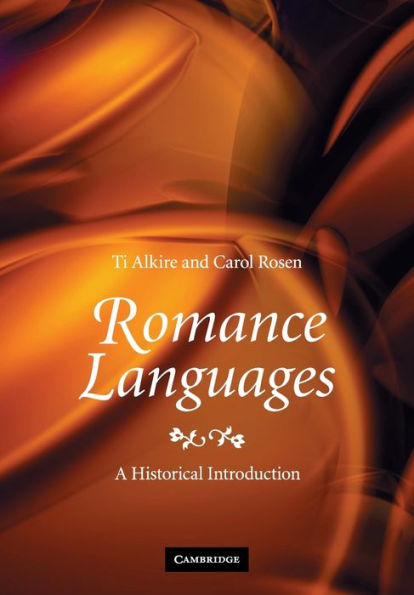Table of Contents
Acknowledgements ix
Introduction 1
1 The evolution of stressed vowels 5
1.1 Syllables and word stress in Latin 5
1.2 Stressed vowels: the (almost) pan-Romance seven-vowel system 8
1.3 Special developments in stressed vowels 19
1.4 The three Latin diphthongs 23
Exercises 24
2 Early changes in syllable structure and consonants 26
2.1 Prosthetic vowels 26
2.2 Syncope and new consonant clusters 28
2.3 Merger of /b/ and /w/ 31
2.4 Early consonant losses 33
2.5 In search of Popular Latin speech 36
Exercises 40
3 Consonant weakening and strengthening 44
3.1 Degemination 44
3.2 Lenition 45
3.3 Other consonant weakenings 48
3.4 Fortition 52
Exercises 53
4 New palatal consonants 56
4.1 About palatal articulation 56
4.2 Yods old and new 57
4.3 Yods and the growth of new consonants 58
4.4 Charles and Charlotte 72
Exercises 74
5 More about vowels: raising, yod effects, and nasalization 77
5.1 Vowel raising in Italian 77
5.2 Yod effects in Spanish 80
5.3 Yod effects in French 86
5.4 Nasal vowels in French 91
Exercises 92
6 Verb morphology: the present indicative 95
6.1 Infinitives 95
6.2 Present indicative in Popular versus standard Latin 99
6.3 Present indicative in Italian 100
6.4 Present indicative in Spanish 102
6.5 Present indicative in French 103
6.6 Stem allomorphy in the present indicative 104
6.7 Paradigm leveling 112
6.8 Paradigm disleveling 116
6.9 A stem extender: -sc- 118
6.10 Some truly irregular verbs: be, have, go 119
Exercises 123
7 Verb morphology: systemic reorganization 127
7.1 Map of the Latin verb system 127
7.2 How Romance reorganizes the Latin system 130
7.3 Present indicative and present subjunctive 133
7.4 Imperfect indicative 140
7.5 Perfect indicative: Romance synthetic past 144
7.6 Imperfect subjunctive 158
7.7 Future subjunctive 162
7.8 Future and conditional 163
7.9 A bombshell: the birth of periphrastic perfects 169
7.10 The passive voice 174
7.11 Past participles old and new 176
Exercises 180
8 Noun and adjective morphology 185
8.1 The starting-point Latin noun and adjective morphology 185
8.2 From five to three declension classes 186
8.3 From six to two cases 187
8.4 Romance noun and adjective morphology 188
8.5 The neuter diaspora: from three to two genders 192
8.6 Toward gender marking 195
8.7 Imparisyllabic nouns and adjectives 196
8.8 Romance personal pronouns 198
8.9 Birth of the definite article 203
Exercises 206
9 History and structure of Portuguese: in overview 209
9.1 Stressed vowels: the seven-vowel system 209
9.2 More on stressed vowels- secondary diphthongs 212
9.3 More on stressed vowels: nasalization 215
9.4 Raising effects 217
9.5 Early changes in consonants 217
9.6 Consonant weakening and strengthening 219
9.7 New palatal consonants 222
9.8 Noun and adjective morphology 228
9.9 Verb morphology: infinitives 234
9.10 Verb morphology: present indicative 234
9.11 Paradigm leveling and disleveling 240
9.12 A stem extender: -sc- 240
9.13 Some truly irregular verbs: be, have, go 241
9.14 Verbs: old categories with inherited morphology 242
9.15 Verbs: new periphrastic 246
9.16 Verbs: other new categories 248
Exercises 250
10 History and structure of Romanian: an overview 252
10.1 Romanian vowels: diachrony and synchrony 252
10.2 Syllable structure: conservatism and innovation 260
10.3 Palatal influences on consonants 261
10.4 Other consonant changes 263
10.5 Present indicative and subjunctive 267
10.6 Verb morphology: systemic reorganization 274
10.7 Noun and adjective morphology 279
Exercises 284
11 Formation of the Romance lexicon 287
11.1 Lexical competition and replacement 287
11.2 Exploiting the derivational resources of Latin 289
11.3 Cycles of added and lost meaning 300
11.4 Reanalysis: how the mind remakes words 304
11.5 Loan words 306
Exercises 314
12 Emergence of the Romance vernaculars 317
12.1 Language in the Carolingian world 317
12.2 The earliest Romance texts 323
12.3 Conclusion from dialects to standards 330
Exercises 335
Notes 339
Glossary of linguistic terms 353
Suggestions for further reading 360
Works cited 364
Index 372






